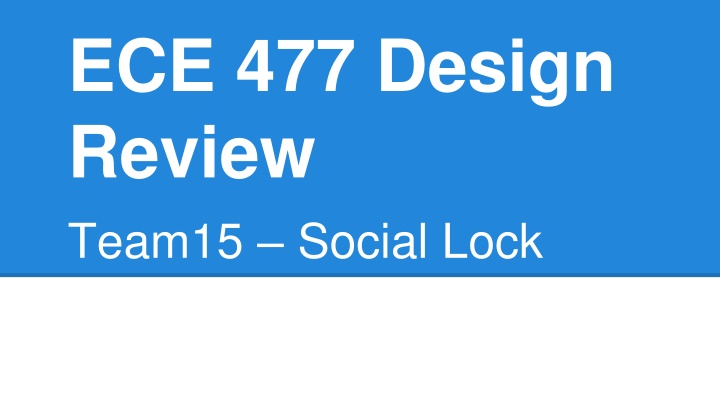
Smart Door Lock System Design Review and Component Selection
"Explore the innovative Smart Door Lock System designed by ECE.477 Team 15, featuring secure mobile device authorization, mechanical deadbolt control, battery monitoring, access management, and more. Learn about the rationale behind component selection, including the use of TI MSP430 microcontroller, Bluegiga BLE112 Bluetooth module, Toshiba H-Bridge, Microchip LDO Regulator, Maxim Battery Monitor, and unique packaging design. Discover the cutting-edge technology and features of this advanced smart lock system."
Download Presentation

Please find below an Image/Link to download the presentation.
The content on the website is provided AS IS for your information and personal use only. It may not be sold, licensed, or shared on other websites without obtaining consent from the author. If you encounter any issues during the download, it is possible that the publisher has removed the file from their server.
You are allowed to download the files provided on this website for personal or commercial use, subject to the condition that they are used lawfully. All files are the property of their respective owners.
The content on the website is provided AS IS for your information and personal use only. It may not be sold, licensed, or shared on other websites without obtaining consent from the author.
E N D
Presentation Transcript
ECE 477 Design Review Team15 Social Lock
Team 2
System Block Diagram Client Phone 1 BT UART BLE112 Bluetooth module MSP430 uC BT Client Phone N BT Parallel HTTP Power Credential server Base station Deadbolt motor H-bridge 3
PSSCs 1. An ability to securely determine whether a given mobile device is authorized to unlock the door. 2. An ability to mechanically displace the deadbolt to unlock and relock the door. 3. An ability to monitor the battery state and indicate a low battery condition to the user. 4. An ability to grant and revoke access to additional smartphones without either being physically present at the lock. 5. An ability to use grant temporary access to additional smartphones which expires automatically at the appointed time. 4
Component Selection Rationale Microcontroller Bluetooth Module H Bridge LDO Regulator Battery Monitor 5
Microcontroller TI MSP430F6659 Strong Community Powerful Our team is familiar with the tools 6
Bluetooth Module Bluegiga BLE112 Built in microcontroller UART Programmable Well-supported 7
H Bridge Toshiba TB6593FNG Low minimum motor supply voltage (< 3V) Low ambient current draw High current capacity (1.2A) Analog control 8
LDO Regulator Microchip Technology MCP1700T Simple, 3 pin package Max power consumption: ~150mW Sleep power consumption: ~15 uW 9
Battery Monitor Maxim 6775XKA+T Low, 0.87uA current draw 1% Accuracy Only need to indicate low battery warning Simpler than coulomb counter 10
Packaging Design 3D printed box that fits over deadbolt Does not require any tools to install Removable adhesive affixes device to door 11
Schematic/Theory of Operation Schematic broken into blocks Each block covered in following slides 12
Power Block Battery leads LDO regulator Battery monitor Power switch 13
Bluetooth Block BLE112A module Decoupling caps uC UART Debug UART 14
Bluetooth Debug Block 10-pin JTAG nRST switch Vcc sense (not supply) 15
Grounds Block Fake resistors Connect AGND, PGND to GND 16
Motor Block H-bridge Decoupling caps uC control 20-SSOP, 5 pins Unregulated VBATT for motor 17
uC Debug Block 14-pin JTAG nRST shared with debugger Backchannel UART Power source selection 18
HW Debug Block Power LED Voltage test points 19
LED Block Output LEDs for uC 20
Switch Block Input switches for uC 21
uC Block Isolated 8 MHz crystal Decoupling caps Signal lines to everything else 22
Power Layout Power switch Indicator LED Back-voltage protection via Schottky diode 24
Motor Layout Pins inconveniently configured Most vias per pin of all components PGND connected to GND at R4 uC at right 25
JTAG-14 Layout Most difficult routing Originally farther from uC Solution: signals from left on top; from right, bottom 26
Jumper Layout Allows selection of uC UART path Includes adjacent nRST switches 27
Oscillator Layout Analog circuit Isolated analog ground plane Equal-length load capacitor traces 28
Switch & LED Layout 8-bit I/O for debugging Switches include PU/PD resistors for safety 29
uC Layout Decoupling caps on bottom layer 30
Bluetooth Layout Signal planes restricted near antenna Chip near corner for minimal EMI Debug UART header 31
Software Structure and Status iOS App: Complete Parse Backend: Complete Base Station: Complete Bluetooth Chip: In Progress MSP430: In Progress 36
Questions? 38
